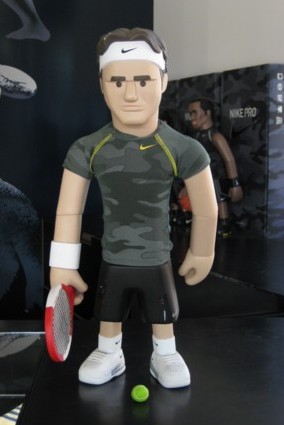The US lost badly to Spain in Davis Cup as that slippery, slidy clay got in the way again.
These are not the words you want coming out of Rafael Nadal’s mouth at the end of a clinching rubber in the Davis Cup semifinals:
Today I played very well. I shocked myself with some of the winners I played, was near perfect tennis.
Nadal had just beaten Andy Roddick on red clay, 6-4, 6-0, 6-4, to give Spain an insurmountable 3-1 lead over the US in a bullring in Madrid. Rain delayed the start of the match and that made things worse because wet clay is slow, muddy clay which is a good antidote for a big server like Roddick. But it wasn’t supposed to come down to this match.
If the US wanted to beat Spain and get to the Davis Cup final for the second year in a row, Roddick had to beat David Ferrer, give Sam Querrey a chance to do the same thing, and hope that Mardy Fish and Mike Bryan could win the doubles rubber because no one was going to beat Nadal. Only one of those things happened and it wasn’t in singles as Spain beat the US 4-1.
It looked promising when Roddick went up two sets to one on Ferrer in the second rubber, but Roddick was making a lot of errors and, ultimately, if the road to a Davis Cup final goes through Spain or Russia on clay, Roddick can fight his heart out as he always does, but it’s too much to expect him to pick up two wins in that situation. It took Ferrer 3 hours and 17 minutes and 14 games in the fifth set, but he finally put Roddick away, 7-6(5), 2-6, 1-6, 6-4, 8-6.
While the US is still developing big serving hard court players like Roddick and Querrey, Spain and Argentina are developing good all round players. Nadal is a ridiculous 39-7 on hard court this year and Ferrer has reached the semifinals at the US Open – which is better than James Blake I might add. And this weekend, Juan Martin Del Potro saved Argentina’s butt by winning both his matches in Buenos Aires. Del Potro won four straight tournaments this summer, two on clay and two on hard court, and he reached the quarterfinals at the US Open. That’s what we call all round tennis.
I hear there are lots of clay courts in Florida but Roddick and Fish both learned their tennis in Florida and it didn’t help them. Querrey grew up in California about an hour away from my home. Now and then I see a broom pushed up against a chain link fence and a green clay court beyond it, but that’s about it.
I think the USTA should develop an exchange program with the Sanchez-Casal Academy in Spain for its promising junior players. The US can teach Spanish players to serve hard – Feliciano Lopez could have stayed home – and US players can learn to slide on clay. I wouldn’t be surprised to learn that registration at the Sanchez-Casal Academy has been growing much faster than registration at Nick Bollettieri’s Academy in Florida for the past few years.
Luckily for Argentina, the Davis Cup final will be on their soil but which surface should they choose? According to my research – though it’s hard to believe – the two countries have only met twice in Davis Cup history, once in 2003 and one in 1926. Both ties were played on clay and Spain won them both.
Argentina should pick a fast indoor surface such as carpet like the US did in the final against Russia last year. The US would have picked an ice rink if they could have gotten away with it. David Nalbandian took both indoor Masters Series events in Paris and Madrid last year and Del Potro is passable indoors. Nadal’s worst results are on carpet and Ferrer has a losing record on the surface and, did I say this already?, no one is going to beat Nadal on clay.
Let me know what happens because I’m loading up my car and taking off in search of red clay courts in the area and it might take me a few months.
